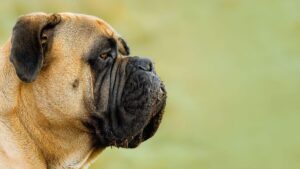
The Night Dog… His Story
This article was originally published in Showsight Magazine, August 2014 issue. The Night Dog… His Story On tough, tight feet and well-developed legs, he
Home » Meet The Breeds » Bullmastiff
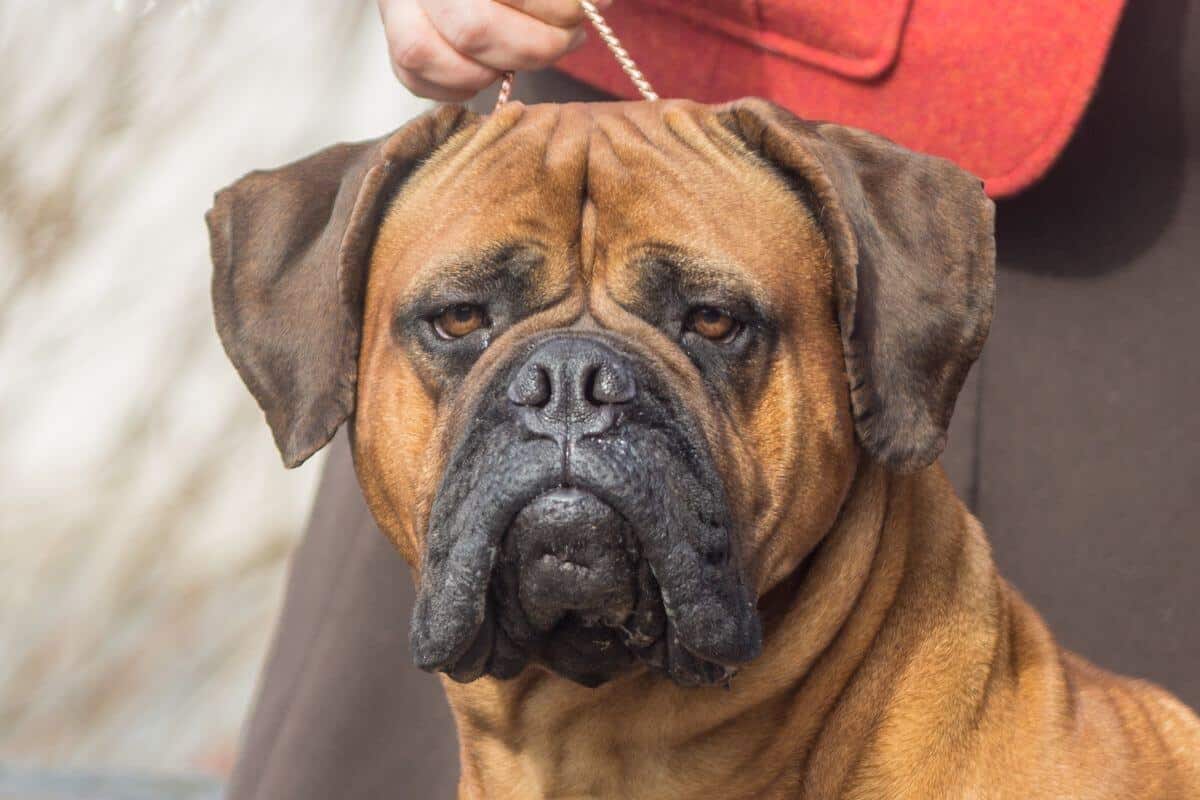
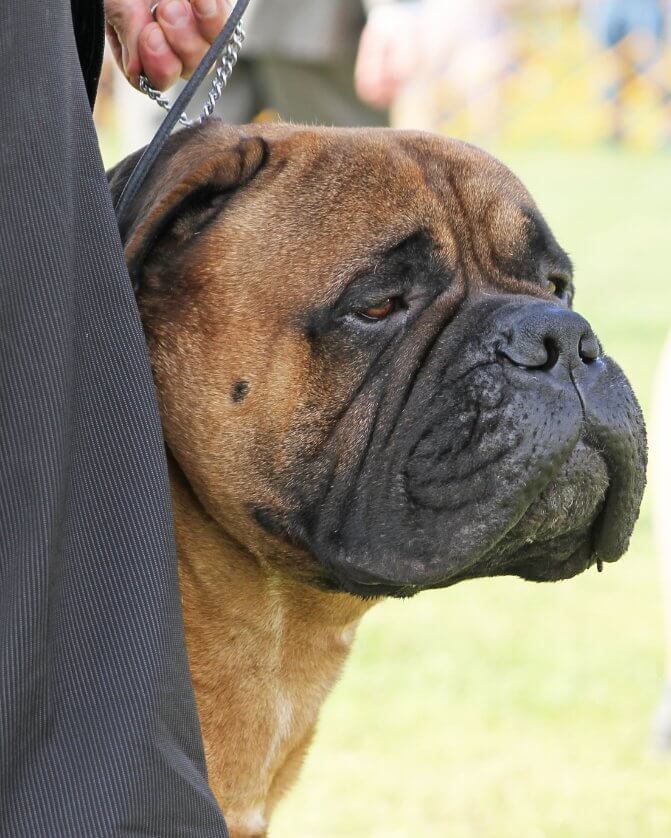

The American Bullmastiff Association
08/04/2025
A Bullmastiff will give a family boundless love and devotion, but will retain a part of himself as a free spirit, capable of making his own decisions and acting on them. Children will be his charges to protect and to love, but they must respect him and not be allowed to tease him.
He asks only to be as much a part of the family as possible. He will reward such treatment with devotion and friendship, which is not exceeded in any breed.
Working
24 – 27 inches
100 – 130 pounds
7 – 9 years
| Country of Origin | United Kingdom |
|---|---|
| Bred For | Combat poaching on the estates they patrolled. |
| Known For | Dependable family companion who combines the reliability, intelligence and willingness to please and protect family members. |
| Popularity | Moderate |
| Temperament | Fearless and Confident yet Docile |
| Activities | Obedience, Rally, Tracking, Fast CAT, Dock Diving, Therapy Dogs |
In the early 19th century, English gamekeepers created this noble breed by crossing the courageous Mastiff with the tenacious Bulldog to produce fleet-footed, powerful dogs for protection against poachers. The original cross combined the courageous Mastiff with the tenacious Bulldog in a 60 percent Mastiff and 40 percent Bulldog proportion. They created a dog that was fleet-footed, and powerful enough to catch and down a poacher for apprehension by the Gamekeeper. The Mastiff, while powerful and courageous, was not fast enough and sufficiently aggressive. The Bulldog was more aggressive but not large enough for the task. This cross resulted in the development of a breed that was totally utilitarian.
Originally called the “Gamekeepers Night Dog,” these dogs combined tremendous strength and guarding instinct with an affectionate disposition and devotion to their masters. The Bullmastiff was recognized in England in 1924 by The Kennel Club as a distinct breed, and by the American Kennel Club in 1933.
The Bullmastiff is an intelligent dog and has a definite mind of his own. His independence of spirit makes a relationship with him more of a working partnership than the conventional dog/master association which some people might expect.
Dogs, 25 to 27 inches at the withers, and 110 to 130 pounds weight. Bitches, 24 to 26 inches at the withers, and 100 to 120 pounds weight. Other things being equal, the more substantial dog within these limits is favored.
The length from tip of breastbone to rear of thigh exceeds the height from withers to ground only slightly, resulting in a nearly square appearance.
Texture: Short and dense, giving good weather protection.
A Note About Color: A clear coat is desirable. Fawn ranges from lightest of fawn to a honey fawn, and red ranges from light rust to dark mahogany. Brindles have an even striped pattern with an undercoat of red or fawn; chevron pattern.
The head of the Bullmastiff is the hallmark of the breed. Good head type is essential, not only for correct appearance, but when the headpiece is properly constructed it is entirely functional.
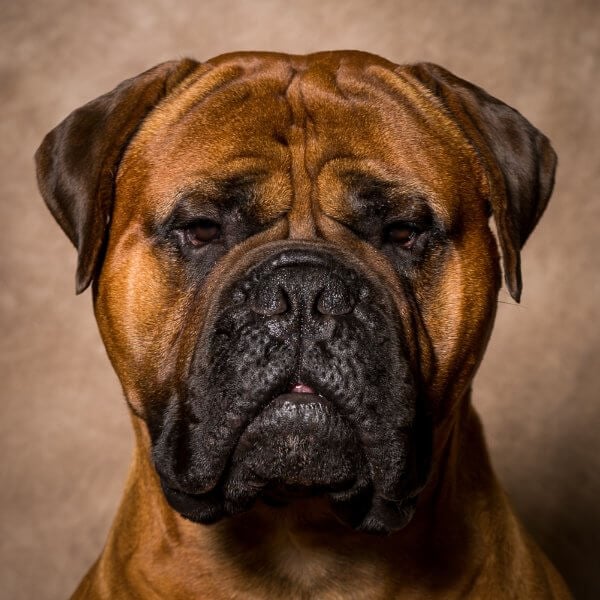
Set on high, strong at the root, and tapering to the hocks. It may be straight or curved, but never carried hound fashion.
The Bullmastiff is a wonderful breed, strong-willed, fearless, and confident. Its temperament is ideal in a home where it is made to understand structure and rules and is loved and wanted as part of the household. A dog that understands its position in the pack (family) is secure and happy. It is a safe pet. It follows the lead of its family superiors.
Responsible Bullmastiff breeders support the American Bullmastiff Association Health & Research Committee, and screen their breeding stock for cardiac issues, hip and elbow dysplasia, hypothyroidism, and eye problems. Bullmastiffs can develop cancer as well as bloat, a sudden and life-threatening swelling of the abdomen; owners should educate themselves about its symptoms and what to do should bloat occur. Heredity and environment play roles in the health of the breed.
Lifespan: 8-10 years
Fearless and confident yet docile. The dog combines the reliability, intelligence, and willingness to please required in a dependable family companion and protector.
Most Bullmastiff breeders advise feeding adult dog food or large-breed puppy food for puppies in order to ensure slow and steady growth. Several small meals are best for puppies, and two meals daily is a good routine for adults, so dogs don’t have to digest too much food at each meal. Because of the risk of bloat, exercise is discouraged immediately before and after eating. Bullmastiffs should be kept lean, especially as puppies, as they grow very rapidly, which can tax their systems.
Early training and socialization are critical for Bullmastiff puppies. The breed can be quite strong-willed, and dogs and owners will both benefit from training regimens instilled in puppyhood. Rules and routines should be put in place early and adhered to as the puppy grows. Many breeders will encourage new owners to enroll in local puppy classes in order to ensure that puppies are exposed to other dogs and that owners have access to training assistance and information. Bullmastiffs can excel in Agility, Obedience, Rally, even Scent Work and Tracking, so training should begin immediately and be a part of the lifelong bond between dog and owner.
Bullmastiffs enjoy daily exercise. Some are more sedentary, while others are very active by nature, but moderate exercise should be encouraged. Brisk walks and outdoor play are favorites of the breed, although secure fencing is a must for outdoor areas. Fencing is critical to ensure that the dog is safely contained and so strangers and unfamiliar animals do not intrude on the Bullmastiff’s territory. Puppies should not be over-exercised, especially during periods of rapid growth. Bullmastiffs are not the ideal breed for people who want a canine running partner, but they are great walking companions.
| Energy Level | Moderate |
|---|---|
| Exercise Requirements | 30 Minutes/Day Daily Walks, Regular Exercise, Mental Stimulation |
Seasonal shedding is to be expected, though unusual hair loss should be noted as a possible problem. A balanced diet and a healthy environment are most important for coat health. Frequent grooming ensures that shedding can be managed, and dogs should be bathed as needed. The skin and coat should be monitored in order to ensure that dryness or oiliness are not issues. These can be related to diet, and sometimes to allergies.
| Coat Type | Short and Dense |
|---|---|
| Grooming Requirements | Trimming: Routine Ear Cleaning, Periodic Nail Trimming, Regular Tooth Brushing |
The dog combines the reliability, intelligence, and willingness to please required in a dependable family companion and protector. He is a dog we can depend on to be consistent in his responses, bright enough to learn what we want, and willing to do what we ask, for whatever reason he attaches to that willingness.
Bullmastiffs are puppies for at least the first year of their lives, and in many breeder lines an additional year as well. Growth plates on male bullmastiffs generally close between 18 months of age and 36 months. Female growth plates close between 12 months and 24 months.
Food – An unbalanced diet in a large breed puppy can lead to serious health complications when the dog is older. Follow your breeder’s guidance in choosing a raw, kibble, or combination diet for your puppy. Be aware of ongoing research and investigations regarding Canine Dilated Cardiomyopathy and grain-free diets or those high in peas, lentils, legume seeds, and/or potatoes. Calcium, phosphorus, and vitamin D are an important part of a growing, giant-breed puppy’s diet. The recommended range for dietary calcium is .8 percent to 1.2 percent in kibble. Excess calcium adversely affects growth and skeletal formation and is associated with developmental orthopedic diseases.
Shelter – Provide your puppy with a safe place in the house to call its own. Generally, Bullmastiffs enjoy their crate space and time. Crate pads, toys, etc., are earned as they mature and learn to manage puppy chewing tendencies.
Health – Puppies should see their new veterinarian within a week of their arrival. Veterinarians will want to see the pup’s vaccination record.
Condition – Puppies require very little in terms of exercise, and should actually be limited from jumping on furniture, up and down stairs, in and out of vehicles, etc., until those growth plates are pretty solid. Bathe your puppy only as necessary with an emollient free canine shampoo.
When your puppy begins teething you may find that their ears are beginning to “fly.” This is a cosmetic condition and is the owner’s choice whether to correct the ears or allow them to be as is. If you’d like to correct the ears, this can be done via taping, a harmless process that can take a couple of months and usually corrects the ear set. There are videos available on the Internet and your breeder will have a recommended method to tape the ears.
The American Bullmastiff Association, Inc. recognizes the outstanding achievements of Bullmastiffs participating in a variety of canine competitions with the Working Dog Performance-Versatility certificate program. The WDP-V certification is acknowledgement of Bullmastiffs that are able to successfully demonstrate the diverse skills required for successful participation in the following categories: Obedience, Conformation, Agility, Rally, Tracking, Therapy, Canine Good Citizen, Coursing Ability, Nosework, Dock Diving and various other miscellaneous activities.
The Bullmastiff is recognized by the world’s leading registries and kennel organizations, which categorize the breed into a specific Group based on its unique characteristics. This breed is recognized worldwide under the following Group designations:
| Organization | Group Designation |
|---|---|
| AKC (American Kennel Club) | Working |
| UKC (United Kennel Club) | Guardian |
| CKC (Canadian Kennel Club) | Working |
| ANKC (Australian National Kennel Council) | Utility |
| RKC (The Royal Kennel Club) | Working |
| FCI (Fédération Cynologique Internationale) | Group 2: Pinscher and Schnauzer Molossoid Breeds – Swiss Mountain and Cattle Dogs; Section 2.1.: Molossoid Breeds, Mastiff Type |
The ideal Bullmastiff is described by a Breed Standard that is approved by each of the world’s leading registries and kennel organizations. The Breed Standards for this breed may be found in the following links:
| Organization | Breed Standard |
|---|---|
| American Kennel Club | AKC Bullmastiff Breed Standard |
| United Kennel Club | UKC Bullmastiff Breed Standard |
| Canadian Kennel Club | CKC Bullmastiff Breed Standard |
| Australian National Kennel Council | ANKC Bullmastiff Breed Standard |
| The Royal Kennel Club | RKC Bullmastiff Breed Standard |
| Fédération Cynologique Internationale | FCI Bullmastiff Breed Standard |
All dogs drool, but sometimes Bullmastiffs may drool more often than other breeds.
The Breed Standard calls for a dog that is between 25-27 inches for a male and between 24-26 inches for a female. Weights are between 110-130 pounds for a male and 100-120 pounds for a female. However, there are many Bullmastiffs that fall either under the Standard or over the Standard. So, you may see a female as small as 22 inches tall and 85 pounds or a male as large as 29 inches tall and 170 pounds or more. Ideally, a breeder breeds to the Breed Standard and the pups that may fall outside the parameters of the Standard are placed as companion animals.
An adult Bullmastiff usually eats between 2 to 3 cups of dry kibble twice a day. This averages out to 40-60 pounds of dog food per month. Some may eat more and some may eat less. Each dog is different, so you need to gauge the amount of food to the size of the dog. The important thing to remember is do not let your Bullmastiff become overweight.
Bullmastiffs do not always get along with other dogs. If you already have a dog in your household, most responsible breeders will recommend getting a Bullmastiff that is the opposite sex. There are always exceptions and breeders know their puppies best, but in general, it’s not advised to have multiple males in a household.
Yes! This breed needs to be an integral part of the family unit. This breed IS a guard breed and does require a lot of early socialization so that they become accepting to everyone you invite into your home. They are very rough as puppies and may knock small children down without even noticing. They would protect you with their life, if the need ever arose.
YES!!! Obedience training is in a class situation and provides socialization as well as valuable training. If your dog is not under control, he may knock someone down and hurt them.

The American Bullmastiff Association is a resource for bullmastiff fanciers, breeders, exhibitors, owners, and all who love this amazing breed.

This article was originally published in Showsight Magazine, August 2014 issue. The Night Dog… His Story On tough, tight feet and well-developed legs, he
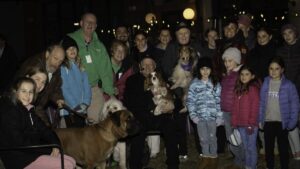
Rufus, a champion Bullmastiff and Therapy Dog, shines as a National Dog Show ambassador, winning hearts and promoting his breed!
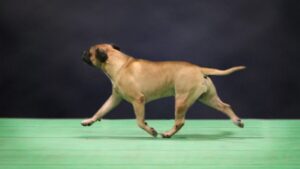
Discover the Bullmastiff’s journey from England’s gamekeeper’s night dog to a modern guardian, and tips for judging this powerful breed.

Olga Contant of Ridgetop Bullmastiffs shares her 36-year journey in breeding, breed standards, and promoting Bullmastiffs today.
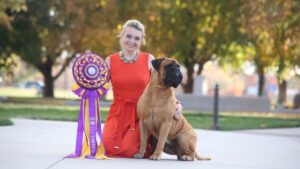
Galina Taylor is the breeder behind Marconian Bullmastiffs. Read about the kennel’s beginnings, puppies, see photos, and much more!
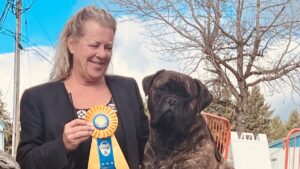
Lynne Rehsler is the breeder behind Banbury Bullmastiffs. Read about the kennel’s beginnings, champion dogs, Pyr puppies, photos & more!
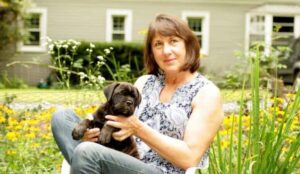
Helene Nietsch is the breeder behind Banstock Bullmastiffs. Learn about the kennel’s origins, puppies, photos, and more!
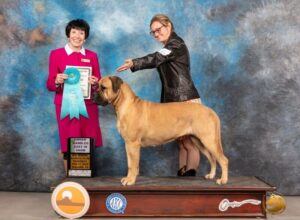
Stacie Toft-Devore is the breeder behind Corral West Kennels. Read about the kennel’s beginnings, champion dogs, puppies, photos & more!
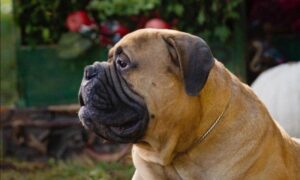
Cheryl Pike is the breeder behind Amulet Bullmastiffs. Read about the kennel’s beginnings, champion dogs, puppies, photos & more!